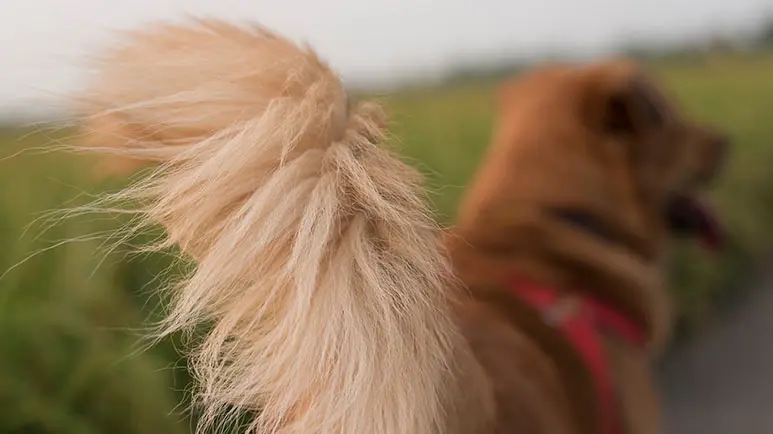The Tail Wagging Mystery Unraveled
Dive deep into the science behind your dog's tail wagging. It's not just a sign of happiness; discover the hidden meanings and evolutionary secrets behind this complex canine behavior.

STORY AT-A-GLANCE
- An opinion piece published in Biology Letters calls into question some long-held beliefs about tail wagging
- A propensity for tail wagging may be one characteristic of "domestication syndrome," along with floppy ears, curly tails and white fur patches
- During the domestication process, humans may have inadvertently selected for dogs that wagged their tails more often due to our brains' preference for rhythmic stimuli
- Tail wagging in dogs could also have been selected during domestication as a direct expression of docility and friendliness
- Wagging is associated with both positive and negative arousal, and may be correlated with arousal-related hormones and neurotransmitters
If your dog is wagging her tail, she's happy — or is she? An opinion piece published in Biology Letters calls into question some long-held beliefs about tail wagging, revealing there's much we don't know about this seemingly straightforward behavior.
While many animals have tails, out of 40 species studied over a four-year period, pet dogs were found to wag them the most. Dogs also wag their tails more often than wolves, and from a younger age, according to bioacousticians Silvia Leonetti of the University of Turin.1
In a paper published in Biology Letters, Leonetti and colleagues reviewed research on why dogs wag their tails, revealing that there's likely much more to it than meets the eye.2
Dogs May Wag Their Tails Due to Domestication
In the 1800s, Charles Darwin observed distinct characteristics in domesticated animals compared to their wild counterparts. Along with increased docility, domesticated animals often display traits such as floppy ears, white fur patches, curly tails and reduced head and snout sizes. Referred to as "domestication syndrome," a propensity for tail wagging may be among them.
One revealing example is the "Russian farm-fox experiment" of 1959, which sought to replicate domestication by selectively breeding foxes with the friendliest traits. Within 10 generations of targeted breeding, notable changes emerged in the foxes' behavior, including tail-wagging toward humans, as did physical changes including increased ear folding, tail curling, reduced head size and alterations in fur coloration.3
The Biology Letters paper similarly suggested, "During the domestication process, enhanced rhythmic tail wagging behavior could have (i) arisen as a by-product of selection for other traits, such as docility and tameness, or (ii) been directly selected by humans, due to our proclivity for rhythmic stimuli."4
Based on the fox study, the researchers suggested that tail wagging in dogs as seen today "could have arisen as a direct expression of docility/friendliness." Another possibility is that, during the domestication process, humans inadvertently selected for dogs that wagged their tails more often. According to the study:5
"We call this the 'domesticated rhythmic wagging' hypothesis. Tail wagging is a stereotyped, cyclical and rhythmic behavior. Extensive multidisciplinary evidence shows that humans have remarkable abilities to perceive and produce rhythmic sequences, particularly isochronous patterns where events are evenly spaced in time.
How this behavioral trait appeared in humans is still not clear, but cognitive neuroscience shows that human brains prefer rhythmic stimuli, which trigger pleasurable responses and engage brain networks that are part of the reward system. This propensity for isochronous rhythms could have driven human selection for the conspicuous rhythmic wagging of the tail in dogs, and could explain why dogs exhibit it so often in human–dog interactions."
Wags May Reveal Complex Communications
Interestingly, while tail wagging is rhythmic in dogs, it's also asymmetric. In general, dogs may wag to the right side when they encounter something pleasant, but when they see something threatening, for example, a strange dog exhibiting dominant behaviors, they wag more to the left side.6 This is one example of the complex way dogs may use wags to communicate — including with other dogs.
Study author Taylor Hersh of Oregon State University told Science that tail wagging's asymmetry was among her favorite findings in the study:7
"Often if there's something a dog encounters that it wants to approach, it wags more to the right side of its body, whereas if there's something it wants to withdraw from, it wags to the left side of its body. Perhaps the coolest thing is that dogs can perceive those asymmetries in other dogs.
There's a really neat study where they showed dogs video silhouettes of a dog either wagging to the left side of its body or to the right. They found that they responded differently [with dogs acting more anxious when the silhouette dog was wagging to the left]. I've started noticing it in my own daily interactions with dogs."
Meanwhile, tail wagging is associated with both positive and negative arousal, and may be correlated with arousal-related hormones and neurotransmitters, the study found. The "love hormone" oxytocin has also been indirectly linked with tail wagging, particularly when dogs reunite with a familiar person.8
Tail Wags Aren't Always a Sign of a Happy Pup
That being said, it's not a given that tail wagging signals a happy pup. One study the team reviewed looked into how dogs in animal shelters wagged their tails in response to being pet. All the dogs wagged their tails more when a person pet them, but only dogs admitted as strays had levels of the stress hormone cortisol decrease as well.
Dogs surrendered by their owners didn't have a drop in cortisol. "In both cases, the dogs were wagging their tails more when they were being pet, but their stress levels changed differently depending on their life history," Hersh explained.9 Another study found aggressive dogs wagged their tails more often than nonaggressive dogs, again hinting that we can't assume tail wagging always signals a positive emotion.10
As it stands, the scientists described dog tail wagging as a "conspicuous yet scientifically elusive behavior" that's still poorly understood.11 In the future, evolutionary cognitive scientist Andrea Ravignani of the Sapienza University of Rome, another of the study's authors, told Science that monitoring what's going on in a dog's brain as she wags her tail may shed light on this surprisingly mysterious behavior:12
"I'd like to understand what happens in the brain, the mechanism behind what we are seeing. We still don't know exactly which parts of the dog brain control which features of the tail wagging. Is tail wagging for dogs similar to breathing that we can partly control? Or is it similar to blushing? Do rhythmic areas in dog brains activate? I would also want to see whether abstract thinking areas, communication areas, and so on, activate. It's a whole world of possibilities to explore and understand."














